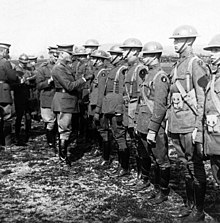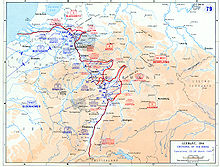89th Infantry Division (United States)
This article needs additional citations for verification. (January 2013) |
| 89th Infantry Division 89th Division | |
|---|---|
 89th Infantry Division shoulder sleeve insignia | |
| Active | 1917 – 1919 1921 – 1945 1947 – 1973 |
| Country | |
| Branch | |
| Type | Infantry |
| Size | Division |
| Nickname(s) | "The Rolling W" |
| Engagements | World War I
|
| Commanders | |
| Notable commanders | Leonard Wood William M. Wright John C. H. Lee |
The 89th Infantry Division, originally known as the "89th Division," was an infantry formation of the United States Army that was active during World War I, World War II, and the Cold War.
History
World War I
The 89th Division was officially established by the War Department on 5 August 1917, four months after the American entry into World War I, at Camp Funston, Fort Riley, Kansas. On 27 August, Major General Leonard Wood, formerly the Chief of Staff of the United States Army, assumed command. Organization of the division began during the last week of August, with a cadre of officers and men of the Regular Army, and from officers of the Officers' Reserve Corps and National Army officer graduates of the First Officers Training Camp held at Fort Riley. From September 5-10, the initial draft of 2,200 Selective Service men arrived, and from Sept 19-24, an additional 18,600 arrive. The drafted men came from Arizona, Colorado, Kansas, Missouri, Nebraska, New Mexico, and South Dakota.
The 353rd Infantry was organized with men from Kansas, the 354th Infantry with men from southeastern and eastern Missouri, the 355th Infantry with men from Nebraska, and the 356th Infantry with men from northwest Missouri. The 340th Machine Gun Battalion was organized with men from South Dakota, the 341st Machine Gun Battalion principally from men living in the

Systematic training began. Between January and June 1918, arrivals and departures at Camp Funston aggregated 20,000 each, and on April 30, the 89th Division numbered 16,000 men, having been reduced by transfers to the 3rd, 4th, 35th, and other divisions. In May, fresh drafts and transfers completed the division.
The division, now commanded by Major General
Order of battle
- Headquarters, 89th Division
- 177th Infantry Brigade
- 353rd Infantry Regiment
- 354th Infantry Regiment
- 341st Machine Gun Battalion
- 178th Infantry Brigade
- 355th Infantry Regiment
- 356th Infantry Regiment
- 342nd Machine Gun Battalion
- 164th Field Artillery Brigade
- 340th Field Artillery Regiment (75 mm)
- 341st Field Artillery Regiment (75 mm)
- 342nd Field Artillery Regiment (155 mm)
- 314th Trench Mortar Battery
- 340th Machine Gun Battalion
- 314th Engineer Regiment
- 314th Field Signal Battalion
- Headquarters Troop, 89th Division
- 314th Train Headquarters and Military Police
- 314th Ammunition Train
- 314th Supply Train
- 314th Engineer Train
- 314th Sanitary Train
- 353rd-356th Ambulance Companies and Field Hospitals
Between the wars
The division was reconstituted in the
The headquarters and staff usually trained with the staff of the 14th Infantry Brigade,

Order of battle, 1939
- Headquarters (Omaha, NE)
- Headquarters, Special Troops (Omaha, NE)
- Headquarters Company (Omaha, NE)
- 89th Military Police Company (Alliance, NE)
- 89th Signal Company (Omaha, NE)
- 314th Ordnance Company (Medium) (Beatrice, NE)
- 89th Tank Company (Light) (Scottsbluff, NE)
- 177th Infantry Brigade (Wichita, KS)
- 353rd Infantry Regiment (Wichita, KS)
- 354th Infantry Regiment (Kansas City, KS)
- 178th Infantry Brigade (Norfolk, NE)
- 355th Infantry Regiment (Omaha, NE)
- 356th Infantry Regiment (Sioux Falls, SD)
- 164th Field Artillery Brigade (Topeka, KS)
- 314th Engineer Regiment (Grand Island, NE)
- 314th Medical Regiment (Omaha, NE)
- 414th Quartermaster Regiment (Mitchell, SD)
World War II
The 89th Infantry Division landed in France at

Order of battle
- Headquarters, 89th Infantry Division
- 353rd Infantry Regiment
- 354th Infantry Regiment
- 355th Infantry Regiment
- Headquarters and Headquarters Battery, 89th Infantry Division Artillery
- 340th Field Artillery Battalion (105 mm)
- 341st Field Artillery Battalion (105 mm)
- 563rd Field Artillery Battalion (155 mm)
- 914th Field Artillery Battalion (105 mm)
- 314th Engineer Combat Battalion
- 314th Medical Battalion
- 89th Cavalry Reconnaissance Troop (Mechanized)
- Headquarters, Special Troops, 89th Infantry Division
- Headquarters Company, 89th Infantry Division
- 789th Ordnance Light Maintenance Company
- 89th Quartermaster Company
- 89th Signal Company
- Military Police Platoon
- Band
- 89th Counterintelligence Corps Detachment
World War II combat record
- Ordered into active service: 5 July 1942 at Camp Carson, Colorado
- Overseas: 10 January 1945.
- Campaigns: Central Europe
- Days of Combat: 57
- Entered Combat: 12 March 1945
- Killed in Action: 292[3]
- Total Casualties: 1,029[4]
- Awards: DSM-1 ; SS-46; LM-5; SM-1 ; BSM-135 ; AM-17.
- Commanders:Maj. Gen. William H. Gill (July 1942-February 1943),Maj. Gen. Thomas D. Finley (February 1943 to inactivation).
- Returned to United States: 16 December 1945.
- Inactivated: 27 December 1945 at Camp Kilmer, New Jersey
Postwar
The 89th was reactivated as a Reserve unit in 1947 with headquarters in Wichita, Kansas and redesignated as the 89th Division (Training) in 1959. In 1973 the division colors were cased and the shoulder patch (but not the lineage and honors) was continued in use as the 89th Army Reserve Command (ARCOM); ARCOMs were not tactical commands, but were instead regional conglomerations of unrelated units. Upon mobilization, units within the ARCOMs would be assigned to active duty units with which they were aligned. The 89th ARCOM was later redesignated as the 89th Regional Support Command, and in 2003 it became the 89th Regional Readiness Command. In its 2005 BRAC recommendations, United States Department of Defense recommended realigning the Wichita U.S. Army Reserve Center by disestablishing the 89th Regional Readiness Command. This recommendation was part of a larger recommendation to reengineer and streamline the command and control structure of the Army Reserve that would create the Northwest Regional Readiness Command at Fort McCoy, Wisconsin.[5] The 89th currently exists as the 89th Sustainment Brigade in the Reserve.
See also
- Charles Denver Barger- Medal of Honor recipient
- David B. Barkley - Medal of Honor recipient
- Marcellus H. Chiles - Medal of Honor recipient
- M. Waldo Hatler - Medal of Honor recipient
- J. Hunter Wickersham - Medal of Honor recipient
- Jesse N. Funk - Medal of Honor recipient
- Harold A. Furlong – Medal of Honor recipient
- Charles E. Kilbourne - Medal of Honor and Distinguished Service Cross recipient who served as the 89th Division's chief of staff in World War I
- Milton C. Portmann Professional football player, Silver Star, Order of Leopold WWI
- Charles T. Payne - (great-uncle of Barack Obama, the 44th President of the United States)
- Marcelino Serna - the most decorated soldier from Texas in World War I.
- Ferdinand Louis Schlemmer – Division camouflage officer in World War I and noted artist in civilian life.
- Maurice Rose - future commander of the 3rd Armored Division during World War II who served with the 89th Division during World War I
- John C. H. Lee - future lieutenant general who served as aide-de-camp to Major General Leonard Wood at Ft. Riley, then as 89th Div. Chief of Staff in the AEF under MG Winn, and the youngest full-colonel in WWI.
- James H. Reeves Colonel, Commander of The 353rd, distinguished service medal, Citation l' Order 32nd corps France 1919, Military distinguished service medal and two silver stars for the Spanish American war in Cuba.
Footnotes
- ^ English, George H., Jr. (1920). History of the 89th Division, U.S.A.; From its Organization in 1917, Through its Operations in the World War, the Occupation of Germany and Until Demobilization in 1919. Kansas City, Missouri: War Society of the 89th Division. p. 22-23.
{{cite book}}: CS1 maint: multiple names: authors list (link) - ^ Clay, Steven E. (2010). U.S. Army Order of Battle, 1919-1941, Volume 1. The Arms: Major Commands and Infantry Organizations, 1919-41. Fort Leavenworth, KS: Combat Studies Institute Press. p. 263-264.
 This article incorporates text from this source, which is in the public domain.
This article incorporates text from this source, which is in the public domain.
- ^ Army Battle Casualties and Nonbattle Deaths in World War II, Final Report (Statistical and Accounting Branch Office of the Adjutant General, 1 June 1953)
- ^ Army Battle Casualties and Nonbattle Deaths in World War II, Final Report (Statistical and Accounting Branch Office of the Adjutant General, 1 June 1953)
- ^ Pike, John. "89th Regional Readiness Command".
Bibliography
- 89th Infantry Division website: http://www.89infdivww2.org/index.htm.
- The Army Almanac: A Book of Facts Concerning the Army of the United States U.S. Government Printing Office, 1950 reproduced at http://www.history.army.mil/html/forcestruc/cbtchron/cbtchron.html Archived 21 March 2021 at the Wayback Machine
- Davis, Henry Blaine Jr. Generals in Khaki. Raleigh, NC: Pentland Press, 1998. OCLC 231779136
Further reading
- Price, Craig (December 2018). "Meuse-Argonne: The Final Push to Victory". VFW Magazine. Vol. 106, no. 3. Kansas City, Mo.: ISSN 0161-8598.
For Doughboys of the 89th Infantry Division, a desperate fight in a French forest illustrated the brutality of World War I's final months. The Meuse-Argonne Offensive was the war's largest and bloodiest campaign for U.S. troops, but it marked the beginning of the end of the war.
